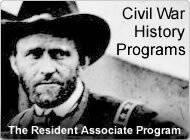
Biography - Mary Ann Hall, 19th Century Entrepreneur
The Smithsonian Associates Civil War E-Mail Newsletter, Volume 4, Number 1
In 1840, a stagnant canal drained through the center of Washington, dividing the area where the Smithsonian Castle stands from the rest of the city. The area was called "The Island." A few blocks to the east is where Mary Ann Hall settled, started a business, saved her money, and where she eventually built a large, three-story brick home. Mary Ann was just in her early twenties, and the neighborhood was--rough. Nearby neighborhoods were nicknamed "Louse Alley," and even "Murderer's Row." While the census records show that most single women here listed their occupation as seamstress or laundress, Mary Ann's occupation isn't recorded anywhere. But all the physical evidence indicates she was an extremely successful businesswoman.
The house was located at 349 Maryland Avenue. That's just about four blocks west of the U.S. Capitol, where it's believed she conducted a majority of her business. During the Civil War, the area bustled with activity. Washington was a boomtown, filled with army encampments, "groggeries," hospitals, an active seaport, and ever present politicians.
It didn't take long for Mary Ann's home to skyrocket in value, and records show her personal property increased as well. She was even written up in the Evening Star, which noted that her home was among the "upper-ten" in the city. Life was good for Mary Ann. The remains of her trash heap tells much more. The land on which her house stood had never been disturbed before or since by any major construction. That is, until about 1999, when construction for the National Museum of the American Indian began.
Professional archaeologists were called in to interpret the site. The foundations of her home and original garbage heap were still in tact. The broken dishes, bottles, and kitchen trash tell the story of her everyday life. We find that the quality of the materials was better than that of the surrounding neighborhood. The tableware was expensive ironstone and porcelain. The seeds and bones show a nutritional diet that included substantial amounts of meat, fowl, and fish, as well as exotic fruits like coconuts and berries. Dozens of corks and bottles were uncovered. Mary Ann seems to have loved champagne.
She often vacationed at her summer home in "Alexandria County," (present-day Arlington, Virginia) land where Marymount University now sits. But she died in the District at the age of 71. Her obituary in the Evening Star sang her praises, "With integrity unquestioned, a heart ever open to appeals of distress, a charity that was boundless, she is gone; but her memory will be kept green by many who knew her sterling worth." Her surviving brothers and sisters then sued each other to get to know that sterling worth better!
Because of this family feud, we have a detailed account of Mary Ann's possessions. District of Columbia court records show that at the time of her death, Mary Ann Hall was worth a grand total of $87,000, with no debts--that's well over $2,000,000 in today's dollars. The records also show a list of her belongings, which included Belgian carpets, oil paintings, an ice box, numerous pieces of red plush furniture, as well as an inordinate number of sheets, mattresses, blankets, feather pillows and comforters.
Mary Ann never married or had children. There are no photographs. She didn't keep a diary. She didn't leave a collection of personal letters or business correspondence. She didn't write her memoirs in her old age. What we know about Mary Ann Hall we learned from cold court records, census bureau documents, and a trash heap. It all tells quite a lot about her life, but not a lot about the person who was Mary Ann Hall.

